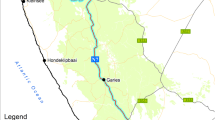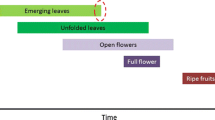Abstract
Vegetation mapping requires extensive field data for training and validation. Volunteered geographic information in the form of geotagged photos of identified plants has the potential to serve as a supplemental data source for vegetation mapping projects. In this study, we compare the locations of specific taxa from the iNaturalist platform to locations identified on both a fine-scale vegetation map and high-resolution ortho-imagery in open-canopy shrubland in San Clemente Island, CA. Due to positional uncertainty associated with the iNaturalist observations, as well as the presence-only nature of the data, it was not possible to perform a traditional accuracy assessment. We instead measured the distance between the location recorded by an iNaturalist observer for a given taxon and the closest mapped individual of that taxon. This distance was within 10 m for a majority of the observations (64%). When comparing the iNaturalist location to the closest individual detected through image interpretation, 87% of the observations were within 10 m. The discrepancy in agreement between the vegetation map and imagery is likely due to mapping errors. While iNaturalist data come with important limitations, the platform is an excellent resource for supporting vegetation mapping and other ecological applications.




Similar content being viewed by others
References
Apple Inc. (2020). Apple Developer Documentation. https://developer.apple.com/documentation/corelocation/clvisit/1614679-horizontalaccuracy#declarations.
Austen, G. E., Bindemann, M., Griffiths, R. A., & Roberts, D. L. (2018). Species identification by conservation practitioners using online images: accuracy and agreement between experts. PeerJ, 6, e4157. https://doi.org/10.7717/peerj.4157.
Beaubien, E. G., & Hall-Beyer, M. (2003). Plant phenology in Western Canada: trends and links to the view from space. Environmental Monitoring and Assessment, 88(1–3), 419–429. https://doi.org/10.1023/A:1025597829895.
Biederman, L. A., Derek, A., Nancy, S., John, P., Judy, B., & Jeanne, P. (2018). Using phenological monitoring in situ and historical records to determine environmental triggers for emergence and anthesis in the rare orchid Platanthera praeclara Sheviak & Bowles. Global Ecology and Conservation, 16, e00461. https://doi.org/10.1016/j.gecco.2018.e00461.
Conrad, C. C., & Hilchey, K. G. (2011). A review of citizen science and community-based environmental monitoring: issues and opportunities. Environmental Monitoring and Assessment, 176(1–4), 273–291. https://doi.org/10.1007/s10661-010-1582-5.
Eitzel, M. V., Cappadonna, J. L., Santos-Lang, C., Duerr, R. E., Virapongse, A., West, S. E., et al. (2017). Citizen science terminology matters: exploring key terms. Citizen Science: Theory and Practice, 2(1), 1. https://doi.org/10.5334/cstp.96.
ElQadi, M. M., Dorin, A., Dyer, A., Burd, M., Bukovac, Z., & Shrestha, M. (2017). Mapping species distributions with social media geo-tagged images: case studies of bees and flowering plants in Australia. Ecological Informatics, 39(February), 23–31. https://doi.org/10.1016/j.ecoinf.2017.02.006.
Elwood, S., Goodchild, M., & Sui, D. (2013). Crowdsourcing geographic knowledge: volunteered geographic information (VGI) in theory and practice. Crowdsourcing Geographic Knowledge: Volunteered Geographic Information (VGI) in Theory and Practice, 9789400745, 1–396. https://doi.org/10.1007/978-94-007-4587-2.
Fonte, C. C., Bastin, L., See, L., Foody, G., & Lupia, F. (2015). Usability of VGI for validation of land cover maps. International Journal of Geographical Information Science, 29(7), 1269–1291. https://doi.org/10.1080/13658816.2015.1018266.
Foody, G. M., Pal, M., Rocchini, D., Garzon-Lopez, C. X., & Bastin, L. (2016). The sensitivity of mapping methods to reference data quality: training supervised image classifications with imperfect reference data. ISPRS International Journal of Geo-Information, 5(11). https://doi.org/10.3390/ijgi5110199.
Goodchild, M. F. (2007). Citizens as sensors: the world of volunteered geography. GeoJournal, 69(4), 211–221. https://doi.org/10.1007/s10708-007-9111-y.
Hawthorne, T. L., Elmore, V., Strong, A., Bennett-Martin, P., Finnie, J., Parkman, J., Harris, T., Singh, J., Edwards, L., & Reed, J. (2015). Mapping non-native invasive species and accessibility in an urban forest: a case study of participatory mapping and citizen science in Atlanta, Georgia. Applied Geography, 56, 187–198. https://doi.org/10.1016/j.apgeog.2014.10.005.
Heider, K., Lopez, J. M. R., & Scheffran, J. (2018). The potential of volunteered geographic information to investigate peri-urbanization in the conservation zone of Mexico City. Environmental Monitoring and Assessment, 190(4), 219. https://doi.org/10.1007/s10661-018-6597-3.
Hereford, J., Schmitt, J., & Ackerly, D. D. (2017). The seasonal climate niche predicts phenology and distribution of an ephemeral annual plant, Mollugo verticillata. Journal of Ecology, 105(5), 1323–1334. https://doi.org/10.1111/1365-2745.12739.
iNaturalist. (2019a). What is it. https://www.inaturalist.org/pages/what+is+it. Accessed 24 February 2020.
iNaturalist. (2019b). Trips enable the collection of presence-absence data by adding context to your observations. https://www.inaturalist.org/pages/trips. Accessed 24 February 2020.
Isaac, N. J. B., van Strien, A. J., August, T. A., de Zeeuw, M. P., & Roy, D. B. (2014). Statistics for citizen science: extracting signals of change from noisy ecological data. Methods in Ecology and Evolution, 5(10), 1052–1060. https://doi.org/10.1111/2041-210X.12254.
Iwao, K., Nishida, K., Kinoshita, T., & Yamagata, Y. (2006). Validating land cover maps with degree confluence project information. Geophysical Research Letters, 33(23), 1–5. https://doi.org/10.1029/2006GL027768.
Jacobs, C., & Zipf, A. (2017). Completeness of citizen science biodiversity data from a volunteered geographic information perspective. Geo-Spatial Information Science, 20(1), 3–13. https://doi.org/10.1080/10095020.2017.1288424.
Jensen, J. R. (2007). Remote sensing of the environment: an earth resource perspective (2nd ed.). Upper Saddle River: Pearson Prentice Hall.
Keßler, C., Maué, P., Heuer, J. T., & Bartoschek, T. (2009). Bottom-up gazetteers: learning from the implicit semantics of geotags. In International conference on GeoSpatial Sematics (pp. 83–102). Berlin, Heidelberg: Springer. https://doi.org/10.1007/978-3-642-10436-7_6.
Lonhart, S. I., Jeppesen, R., Beas-Luna, R., Crooks, J. A., & Lorda, J. (2019). Shifts in the distribution and abundance of coastal marine species along the eastern Pacific Ocean during marine heatwaves from 2013 to 2018. Marine Biodiversity Records, 12(1), 1–15. https://doi.org/10.1186/s41200-019-0171-8.
Merry, K., & Bettinger, P. (2019). Smartphone GPS accuracy study in an urban environment. PLoS One, 14(7), e0219890. https://doi.org/10.1371/journal.pone.0219890.
Miller-Rushing, A. J., Primack, R. B., Primack, D., & Mukunda, S. (2006). Photographs and herbarium specimens as tools to document phenological changes in response to global warming. American Journal of Botany, 93(11), 1667–1674. https://doi.org/10.3732/ajb.93.11.1667.
Mueller, M. A., Drake, D., & Allen, M. L. (2019). Using citizen science to inform urban canid management. Landscape and Urban Planning, 189(May 2018), 362–371. https://doi.org/10.1016/j.landurbplan.2019.04.023.
Pimm, S. L., Alibhai, S., Bergl, R., Dehgan, A., Giri, C., Jewell, Z., Joppa, L., Kays, R., & Loarie, S. (2015). Emerging technologies to conserve biodiversity. Trends in Ecology & Evolution, 30(11), 685–696. https://doi.org/10.1016/j.tree.2015.08.008.
Powell, R. L., Matzke, N., De Souza, C., Clark, M., Numata, I., Hess, L. L., et al. (2004). Sources of error in accuracy assessment of thematic land-cover maps in the Brazilian Amazon. Remote Sensing of Environment, 90(2), 221–234. https://doi.org/10.1016/j.rse.2003.12.007.
Richart, C. H., Chichester, L. F., Boyer, B., & Pearce, T. A. (2018). Rediscovery of the southern California endemic American Keeled Slug Anadenulus cockerelli (Hemphill, 1890) after a 68-year hiatus. Journal of Natural History, 53, 1515–1531. https://doi.org/10.1080/00222933.2018.1447700.
Rocchini, D., Petras, V., Petrasova, A., Horning, N., Furtkevicova, L., Neteler, M., Leutner, B., & Wegmann, M. (2017). Open data and open source for remote sensing training in ecology. Ecological Informatics, 40(May), 57–61. https://doi.org/10.1016/j.ecoinf.2017.05.004.
Sawyer, J. O., Keeler-Wolf, T., & Evens, J. M. (2009). A manual of California vegetation (Second ed.). Sacramento: California Native Plant Society.
Schoenherr, A. A., Feldmeth, C. R., & Emerson, M. J. (2003). Natural history of the islands of California. Berkeley: Univ of California Press.
See, L., Mooney, P., Foody, G., Bastin, L., Comber, A., Estima, J., Fritz, S., Kerle, N., Jiang, B., Laakso, M., Liu, H. Y., Milčinski, G., Nikšič, M., Painho, M., Pődör, A., Olteanu-Raimond, A. M., & Rutzinger, M. (2016). Crowdsourcing, citizen science or volunteered geographic information? The current state of crowdsourced geographic information. ISPRS International Journal of Geo-Information, 5(5). https://doi.org/10.3390/ijgi5050055.
Senaratne, H., Mobasheri, A., Ali, A. L., Capineri, C., & Haklay, M.(Muki). (2017). A review of volunteered geographic information quality assessment methods. International Journal of Geographical Information Science, 31(1), 139–167. https://doi.org/10.1080/13658816.2016.1189556.
Snavely, R., Uyeda, K., Stow, D., O’Leary, J., & Lambert, J. (2019). Mapping vegetation community types in a highly-disturbed landscape: integrating hierarchical object-based image analysis with lidar-derived canopy height data. International Journal of Remote Sensing, 40(11), 4384–4400. https://doi.org/10.1080/01431161.2018.1562588.
Taylor, A. T., Von Schmeling, H., & Long, J. M. (2018). Photographs of wading bird depredation update invasion extent of Monopterus albus (Asian swamp eel). Southeastern Naturalist, 17(4), 72–76. https://doi.org/10.1656/058.017.0408.
Tierra Data Inc. (2011). San Clemente Island vegetation condition and trend analysis, 2010. San Diego: Southwest Division U.S. Naval Facilities Engineering Command.
Tomaštík Jr., J., Tomaštík Sr., J., Saloň, Š., & Piroh, R. (2017). Horizontal accuracy and applicability of smartphone GNSS positioning in forests. Forestry, 90(2), 187–198. https://doi.org/10.1093/forestry/cpw031.
USDA Farm Service Agency. (2020). NAIP Imagery. https://www.fsa.usda.gov/programs-and-services/aerial-photography/imagery-programs/naip-imagery/. Accessed 24 February 2020.
Uyeda, K. A., Warkentin, K. K., Stow, D. A., O’Leary, J. F., Snavely, R., Lambert, J., et al. (2019). Vegetation mapping using hierarchical object-based image analysis applied to aerial imagery and lidar data. Applied Vegetation Science, 23(1), 80-93. https://doi.org/10.1111/avsc.12467.
Van Horn, G., Mac Aodha, O., Song, Y., Cui, Y., Sun, C., Shepard, A., et al. (2017). The iNaturalist species classification and detection dataset. In CVPR (pp. 4–6).
Van Strien, A. J., Van Swaay, C. A. M., & Termaat, T. (2013). Opportunistic citizen science data of animal species produce reliable estimates of distribution trends if analysed with occupancy models. Journal of Applied Ecology, 50(6), 1450–1458. https://doi.org/10.1111/1365-2664.12158.
Vandenlangenberg, S. M., Canfield, J. T., & Magner, J. A. (2003). A regional survey of malformed frogs in Minnesota (USA) (Minnesota malformed frogs). Environmental Monitoring and Assessment, 82(1), 45–61. https://doi.org/10.1023/A:1021684723301.
Waldner, F., Schucknecht, A., Lesiv, M., Gallego, J., See, L., Pérez-Hoyos, A., d'Andrimont, R., de Maet, T., Bayas, J. C. L., Fritz, S., Leo, O., Kerdiles, H., Díez, M., van Tricht, K., Gilliams, S., Shelestov, A., Lavreniuk, M., Simões, M., Ferraz, R., Bellón, B., Bégué, A., Hazeu, G., Stonacek, V., Kolomaznik, J., Misurec, J., Verón, S. R., de Abelleyra, D., Plotnikov, D., Mingyong, L., Singha, M., Patil, P., Zhang, M., & Defourny, P. (2019). Conflation of expert and crowd reference data to validate global binary thematic maps. Remote Sensing of Environment, 221(October 2018), 235–246. https://doi.org/10.1016/j.rse.2018.10.039.
Wallace, C. S. A., Walker, J. J., Skirvin, S. M., Patrick-Birdwell, C., Weltzin, J. F., & Raichle, H. (2016). Mapping presence and predicting phenological status of invasive buffelgrass in Southern Arizona using MODIS, climate and citizen science observation data. Remote Sensing, 8(7). https://doi.org/10.3390/rs8070524.
Acknowledgments
This research would not have been possible without the contributions of numerous iNaturalist users. In addition to the observations of author CHR, iNaturalist users whose observations were used in this research include cedric_lee, vireolanius, shrike2, dmathews, jrebman, stephanomeria, serpophaga, elizabercel, empid, sulavanderplank, madpurdy,stephlbartlett, sue_meiman, terrilldactyl, demi5, jennyh, sabrinamashburn and taylorsteichen.
Availability of data and material (data transparency)
Available at https://arcg.is/1GLPH0
Code availability
Not applicable.
Funding
This project was funded under agreement (Cooperative Agreement Award No: W9126G-18-2-0068) by the U.S. Army Corps of Engineers.
Author information
Authors and Affiliations
Corresponding author
Ethics declarations
Conflict of interest
The authors declare that they have no conflict of interest.
Ethics approval
Not applicable.
Consent to participate
Not applicable.
Consent for publication
Not applicable.
Additional information
Publisher’s note
Springer Nature remains neutral with regard to jurisdictional claims in published maps and institutional affiliations.
Rights and permissions
About this article
Cite this article
Uyeda, K.A., Stow, D.A. & Richart, C.H. Assessment of volunteered geographic information for vegetation mapping. Environ Monit Assess 192, 554 (2020). https://doi.org/10.1007/s10661-020-08522-9
Received:
Accepted:
Published:
DOI: https://doi.org/10.1007/s10661-020-08522-9




